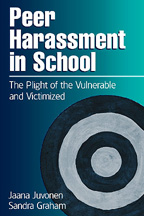 by Edited by Jaana Juvonen and Sandra Graham
by Edited by Jaana Juvonen and Sandra Graham
Many youngsters are targets of verbal and physical abuse or social ostracism at some point during their school careers, and a minority are repeatedly victimized by their peers. Which students become the targets of aggressive behavior, and why?
Full Description:
Many youngsters are targets of verbal and physical abuse or social ostracism at some point during their school careers, and a minority are repeatedly victimized by their peers. Which students become the targets of aggressive behavior, and why? What are the psychological and health consequences of victimization? Of crucial importance, what can school professionals do to help? This volume brings together leading investigators to present the latest psychological research on chronically victimized children and adolescents. Chapters review conceptual and methodological issues, identify developmental differences in types of harassment, and explore various reaction patterns associated with victimization. Findings are presented on the correlates and consequences of harassment, from peer rejection to compromised mental and physical health, as well as its role in peer group dynamics. Highlighting the practical implications of current research, the volume discusses a number of school-based prevention and intervention approaches.
"The scope of this volume is extremely impressive. From internationally known researchers, it discusses and carefully distinguishes the various types of hostile behavior experienced by victims of peer harassment. Chapters deal with all aspects of harassment: its causes and effects, the characteristics of victims, and the components of preventive interventions. Special features include analyses of the cognitions of victims, the group processes that lead to harassment, and developmental changes in harassment. This book will be highly valuable for educators, child development researchers, clinicians, and students of social development."
-Thomas J. Berndt, PhD, Department of Psychological Sciences, Purdue University
"This volume provides an important new focus for the field that goes beyond aggression and peer rejection. Leading researchers consider many levels of children's victimization or harassment of one another, addressing the form and impact of these behaviors among individuals, dyads, groups, classrooms, and families. Illuminating the dark side of children's peer relationships, this scholarly and provocative work will be valuable to school practitioners, researchers, and undergraduate and graduate-level students."
-Carolyn U. Shantz, PhD, Wayne State University
440 Pages Size: 6" x 9"
Introduction: Peer Harassment: A Critical Analysis and Some Important Issues, Olweus
I. Conceptual and Methodological Issues in Peer Harassment
1. Variations in Peer Victimization: Relations to Children's Maladjustment, B. K. Ladd and G. W. Ladd
2. An Attributional Approach to Peer Victimization, Graham and Juvonen
3. Detriments of Chronic Victimization by Peers: A Review and New Model of Family Influence, Perry, Hodges, and Egan
4. Self-Views versus Peer Perceptions of Victim Status among Early Adolescents, Juvonen, Nishina, and Graham
5. Sampling Instances of Victimization by Peer Harassment in Middle School: A Methodological Comparison, Pellegrini
II. Subtypes and Age-Related Changes in Peer Harassment
6. The Aggressive Victim of Bullying: Emotional and Behavioral Dysregulation as a Pathway to Victimization by Peers, Schwartz, Proctor, and Chien
7. Early Diagnosis and Prevention of Victimization in Kindergarten, Alsaker and Valkanover
8. Relational Victimization in Childhood and Adolescence: I Hurt You through the Grapevine, Crick, Nelson, Morales, Cullerton-Sen, Casas, and Hickman
9. Victimization among Teenage Girls: What Can Be Done about Indirect Harassment?, Owens, Slee, and Shute
10. Development Context of Peer Harassment in Early Adolescence: The Role of Puberty and the Peer Group, Craig, Pepler, Connolly, and Henderson
III. Correlates and Consequences of Peer Harassment
11. Toward a Process View of Peer Rejection and Harassment, Boivin, Hymel, and Hodges
12. Rejection and Victimization by Peers: Social Perception and Social Behavior Mechanisms, Schuster
13. Health Consequences of Harassment and Prevention, Rigby
14. Characteristics of Victims of School Bullying: Development Changes in Coping Strategies and Skills, Smith, Shu, and Madsen
IV. Beyond the Bully/Victim Dyad
15. Groups, Individuals, and Victimization: A View of the Peer System, Bukowski and Sippola
16. Subtypes of Peer Harassment and Their Correlates: A Social Dominance Perspective, Hawker and Boulton
17. Group View on Victimization: Empirical Findings and Their Implications, Salmivalli
|